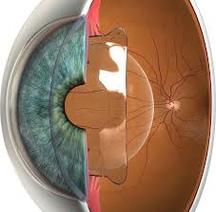What is the ICL?
 ICL is positioned behind the iris
ICL is positioned behind the iris
The Implantable Collamer Lens (ICL) is sometimes known as an Intraocular Contact Lens or a Phakic Intraocular Lens (Phakic IOL). It is a very thin lens, similar to a contact lens. The difference is that the ICL is placed inside the eye, rather than on the surface of the eye. The lens is soft and tiny, much like the natural lens, but does not replace it. The ICL is specially shaped to correct Shortsight and Farsight. The Toric ICL also corrects Astigmatism often found in combination with shortsight and farsight. The lens works in a similar way as spectacles or contact lenses by changing the way light is focused on the retina.
Very high corrections up to -20.00D Shortsight and +8.00D Farsight along with 6.00D of Astigmatism are treatable.
As the ICL is tiny and soft, it can be folded up so small that it can be injected into the eye during a brief operation through a tiny self-sealing opening. Once injected, the ICL unfolds into position in the liquid behind the iris and in front of the natural lens. ICL corrects the eyesight usually without any further treatment being necessary (the ICL can also be removed or replaced, if required, in another simple procedure).
Very high corrections up to -20.00D Shortsight and +8.00D Farsight along with 6.00D of Astigmatism are treatable.
As the ICL is tiny and soft, it can be folded up so small that it can be injected into the eye during a brief operation through a tiny self-sealing opening. Once injected, the ICL unfolds into position in the liquid behind the iris and in front of the natural lens. ICL corrects the eyesight usually without any further treatment being necessary (the ICL can also be removed or replaced, if required, in another simple procedure).
How does the ICL work?
The ICL is made of a unique bio-material called Collamer. Collamer is accepted by the eyes as not being a 'foreign tissue'. This means that the body does not react to or reject the ICL as a foreign body. Other special features of Collamer are its optical clarity and the flexibility and elasticity, that allow it to be folded up and then to recover its correct shape in the liquid inside the eye.
ICLs are intended to remain in place without maintenance. If it becomes necessary, for any reason, ICLs can be easily removed. When compared to laser vision correction surgery, for example LASIK or ASLA/ PRK, ICLs offer a superior quality of vision. Also, because they can be removed and replaced, ICL surgery is reversible and the power of the ICL can be changed if a person's vision requirements change over time, which is not the case for LASIK and other laser surgery.
ICLs are intended to remain in place without maintenance. If it becomes necessary, for any reason, ICLs can be easily removed. When compared to laser vision correction surgery, for example LASIK or ASLA/ PRK, ICLs offer a superior quality of vision. Also, because they can be removed and replaced, ICL surgery is reversible and the power of the ICL can be changed if a person's vision requirements change over time, which is not the case for LASIK and other laser surgery.
How is ICL surgery done?
ICL surgery is performed as a day procedure under local anaesthetic. An overnight admission is not required and patients return home the same day of the surgery. Generally, improvement in vision can be seen the next day but eye drops will be required for about 3-4 weeks with normal postoperative symptoms settling within the first few days in most cases.
Any surgical or invasive procedure carries risks. Before proceeding, you should seek a second opinion from an appropriately qualified health practitioner
Proudly powered by Weebly

